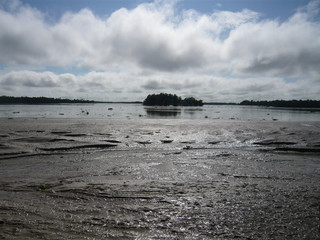If memory had long been a neglected and marginal concept in anthropological research, it has recently become so popular that it has been characterised as a “memory boom”. This trend leads to some problems that become obvious when doing research on memory. Berliner (2005) points out that rarely is memory clearly defined, so that the concept loses precise meaning in a way that everything becomes memory. This might be a source of confusion, as in some studies memory is no longer differentiated from the concepts of identity or culture, for example.
Maybe because it is used in everyday language, the notion is easily appropriated by different actors in various contexts, assigning – voluntarily or not – their own meaning on it. Thus, it is not surprising that its meaning is getting blurred. Working with memory, as other concepts, then requires a critical reflection on the concept and its uses.
One focus of studies of memory is its link to the physical environment. Landscape is frequently described as a store and record of memory. Certainly, the imprints of the past in the present landscape are not to be denied. For Ingold (1993: 152), “the landscape tells – or rather is – a story”. He argues that the environment itself is “pregnant” with the past. Over generations people have moved in it, left their marks and contributed to its formation and therefore, perceiving the landscape is always an act of remembrance, where remembering is not equal to recalling an internal image, stored in the mind, but a perceptual engagement with this “pregnant” environment.
For many societies, landscapes play a vital role in remembering the past; it connects peoples to their history. However, this perspective of landscape as material record of history and memory, and in addition the importance to remember the past – where preserving it appears to be a problem – may be specific to some cultures, for instance to Western societies. Referring to Forty and Küchler (1999), Harrison (2004: 135) notes that for those societies that use objects to remember the past, “a problem history can appear to pose […] is how to preserve it. To them, it is as if the past dissolves unless it is saved in archives, commemorated with monuments or given other durable physical forms.”
In fluid and watery landscapes such as deltas, where water dynamics shape social life and environment, this framework of memory practice is probably inadequate. In a highly dynamic environment, people’s mobility might blur the past, and imprints of past lives and works disappear with an ever changing environment. It would, in this context, make little sense to use fixed geographic references to remember the past.
In this way, some recent studies show evidence, that there is a necessity to find other ways to approach memory in fluid landscapes. Harris (2012: 743) calls for a different approach in a context “where the work of past generations does not lie layered like geological strata.” In an article about memorious and forgetful landscapes, Harrison (2004) challenges general and dominant assumptions by showing that people’s material interaction with the landscape may also enhance processes of forgetting. He suggests that there is a link between watery, fluid and forgetful landscapes. By comparing his findings from the middle Sepik in Papua New Guinea to research about English landscapes, Harrison argues that if the English landscape is described as a book in which successive authors have written, it can be considered as a memourios landscape. In comparison, the landscape of the middle Sepik appears as an actively forgetful one, with water as a main means of unremembering. However, the processes of historical erasure are not entirely natural but enhanced by people’s activities. So, people are actively engaged in the forgetting of their landscapes by fashioning the land in ways that makes their own traces disappears.
Lima and Alencar (2001) show that instead of associating memory with particular places – which is usually done in fixed environments – the memories of floodplain communities in Brazil are continuously disconnected from fixed references as the floodplain changes and reforms. The frequency of people’s moving also complicates a construction of a collective history and memory of the place, as people do not share the same pasts. The authors conclude that in this environment the time period of most interest is the present: people are restarting each year, after each flood, and so their narratives and memories are not linear and chronological but cyclic.
Before and after the flood - Community of Aranha, NE Brazil (Photo Nora Horisberger)
These studies suggest that dominant approaches to memory and landscape can be inappropriate in some contexts. This leads us to ask whether there are other forms of memory: How would memories look like that are not linked to a chronological, historical past? Memories that do not build on fixed references in the physical environment? – In short we should critically rethink dominant approaches to memory and landscapes and consider that especially in fluid environments there might be other forms and appreciations of memory.
Studies of this kind are also important in contrast to a vision that over a long time has been dominant and is still present in Brazil: the description of ribeirinhos (river dwellers) as culturally poor and “without history,” which contributed to their marginal position and invisibility, as much from public policies as from the depictions by anthropologists, who tended to be more interested in the “culturally rich” indigenous Amerindian societies.
As mentioned above, memory is used and appropriated by diverse actors today. For example, in 2014 the NGO “Commissão Ilha Ativa” (Active Island Commission) conducted a project on oral history and memory of a community in the Brazilian Parnaíba Delta, concerned with safeguarding and rescuing of memory and collective history (Galeno, 2014). To cite just one example, the unfamiliarity of some inhabitants with certain parts of the history told by other community members led them to the conclusion that currently there is a detachment between the community and its own history, and therefore it is necessary to maintain it. But what if there has never been a shared collective history in this community?
References
Berliner, D. C. (2005). The abuses of memory: reflections on the memory boom in anthropology. Anthropological Quarterly, 78(1), 197-211.
Galeno, L.S. (2014). Comunidade da Pedra do Sal: Contando Histórias, Relembrando Memórias. Online publication http://comissaoilhaativa.org.br/publicacoes/ (access 12.09.2016).
Harris, M. (2012). The Rhythm of Wetlandlife: Seasonality and Sociality. In: Menotti, F., & O'Sullivan, A. (Eds.). The Oxford handbook of wetland archaeology. OUP Oxford.
Harrison, S. (2004). Forgetful and memorious landscapes. Social anthropology,12(02), 135-151.
Ingold, T. (1993). The temporality of the landscape. World archaeology, 25(2), 152-174.
Lima D. & Alencar, E. (2001). A lembrança da História: Memó́riasocial, ambiente e identidade na várzea do médio Solimões. Lusotopie, 27–48.

